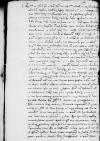Applicui tandem ⌊hic⌋ sospes Deo gratia 1536-12-09⌊IX-a huius1536-12-09⌋, ingressi mecum sunt ⌊Thoronensium⌋ et ⌊Gdanensium⌋ nuntii. Dominus ⌊castellanus Culmensis⌋ et ⌊palatinus Pomeraniae⌋ duobus sequentibus diebus appulerunt et ob id hodie primum summo mane ad faces nos ⌊serenissima maiestas regia⌋ clementer admisit et in frequentia omnium ⌊dominorum Regni⌋ audivit. Reliqua, quae dicenda erant, in aliud tempus sunt suspensa. Convenimus et ⌊serenissimum regem nostrum iuniorem⌋, deinde et ⌊reginalem maiestatem⌋ ab utrisque benigniter excepti multa gratia promissa. ⌊Serenissima maiestas regia⌋ ex debilitate, quam habuit, optime convaluit, incedit sine adminiculo, quo prius utebatur. ⌊Serenissimus rex iunior⌋ per decursum anni non parum excrevit, prae se fertque et habitudinem, et animum optimi principis, neque patri dissimilem. Consultatur hic iam a non paucis diebus, sed adhuc nihil istiusmodi comitiis paper damaged⌈[s]s paper damaged⌉ dignum est absolutum. Nuntii terrarum ⌊Regni⌋ paulo ante dederunt articulos, quos petunt, antequam ⌊rex iunior⌋ praestet iusiurandum, reformari. In iis a summo mane usque post meridiem laboratur parumque admodum est processum. Unde nescitur hucusque, quo tempore iuramentum hoc fieri debeat existimoque nos longe citius, quam oportuit, advenisse, quae hic mora nulli gravius quam mihi detrimento futura est. Quam tamen ferre non detractarem, modo cum meo damno ⌊patriae⌋ prosim. Volunt nos in ⌊Regni consilium⌋ adigere, reluctamur strenue. Ominantur plurimi ⌊conventum⌋ istum ante Paschae festum finem non habiturum, ad cuius celebrationem ecclesiae meae sum astrictus dabiturque a me opera, ut me hinc extricem, quantum possum citius. Venturus est huc pro festo Natalis Domini illustrissimus dominus ⌊Otto Henricus comes palatinus Rheni⌋ ratione dotis maternae. Gravate impetratum est, quod ⌊huc⌋ vocatus sit ill(ustrissimus) dominus ⌊dux vicinus noster⌋, cuius adventus nos hic remorabitur et ut reor, cum statio, ut vocant, illi hic danda sit, nos hinc cum eo forsan expediet.
Agit hic nuntius apostolicus ratione futuri ⌊concilii⌋, quod si quando erit, experiemur rebus sic ubique perturbatis. ⌊Caesar⌋ fertur ex ⌊Genua⌋ pro nervo et gentibus conquirendis traiecisse in ⌊Hispaniam⌋ relicta forti obsidione ad ⌊Massiliam⌋. ⌊Gallum⌋ dicunt conari eruptionem in ⌊Italiam⌋. In ⌊Hun paper damaged⌈[n]n paper damaged⌉garia⌋ paulo ante ⌊Ianussius rex⌋ stratagemate ⌊Cassoviam⌋ cepit
 BCz,244,p. 168
civitatem, quae per tot annos in fide ⌊Romanorum regis Ferdinandi⌋ manserat, neglectis pactis et foederibus etc. Sic habet Dominatio Vestra Reverendissima summam hic rerum omnium. Si quid postea se offeret, per primam opportunitatem non patiar latere Dominationem Vestram Reverendissimam. Cuius paterno amori meme diligentissime commendo. Dominus Deus faxit, ut eandem brevi salvam et incolumem intueri et complecti possim.
BCz,244,p. 168
civitatem, quae per tot annos in fide ⌊Romanorum regis Ferdinandi⌋ manserat, neglectis pactis et foederibus etc. Sic habet Dominatio Vestra Reverendissima summam hic rerum omnium. Si quid postea se offeret, per primam opportunitatem non patiar latere Dominationem Vestram Reverendissimam. Cuius paterno amori meme diligentissime commendo. Dominus Deus faxit, ut eandem brevi salvam et incolumem intueri et complecti possim.
 BCz,244,p. 168
civitatem, quae per tot annos in fide
BCz,244,p. 168
civitatem, quae per tot annos in fide 
